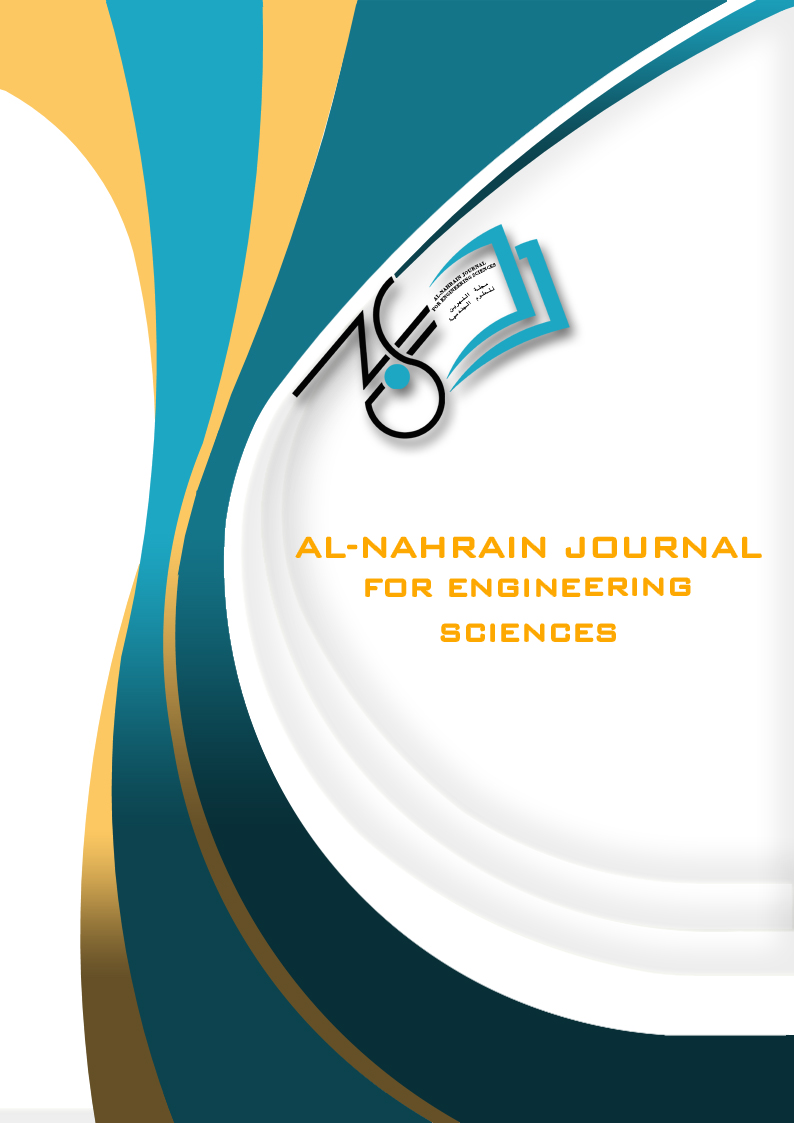Performance Evaluation of Gesture Recognition Using Myo Armband and Gyroscope Sensors
DOI:
https://doi.org/10.29194/NJES.28030461Keywords:
Surface ElectoMyoGraphy, Support Vector Machine, Linear Discriminant Analysis, K-Nearest NeighborsAbstract
The technique of recording muscle signals is crucial in determining how effectively they can be utilized for individual benefit. This study focuses on hand movements recognized by using the Myo armband and Motion Processing Unit (MPU) 6050 sensors. Linear Discriminant Analysis (LDA), K-nearest neighbors (k-NN), and Support Vector Machine (SVM) were employed for classification. sEMG signals using the Myo armband for 7 hand gestures and 2 elbow movements were recorded from 10 healthy subjects. Results showed that SVM outperforms LDA and k-NN in accuracy in both cases, the sensor is worn once on the arm and again on the forearm. regions. The window size and choice of features significantly influence system accuracy, with SVM achieving an average accuracy of 89.84%. Besides that, the fusion of Myo Armband sensor and gyroscope sensor through OR rule makes significant enhancement in recognition accuracy with which is reached to 97.0135%. In conclusion, the Myo armband, when worn on the forearm, proves practical for hand gesture recognition, with SVM offering superior recognition accuracy. Furthermore, the combination of the Myo Armband sensor and the gyroscope sensor showed higher recognition accuracy.
Downloads
References
A. Hogenhuis, “Social network engagement during human-robot interaction,” in Companion of the 2023 ACM/IEEE Int. Conf. on Human-Robot Interaction, Mar. 2023. DOI:10.1145/3568294.3579976 DOI: https://doi.org/10.1145/3568294.3579976
S. Hall and J. Stephens, Anatomy and Physiology. Amsterdam: Elsevier, 2019.
S. Madarshahian and M. L. Latash, “Effects of hand muscle function and dominance on intra-muscle synergies,” Hum. Mov. Sci., vol. 82, p. 102936, Apr. 2022. DOI:10.1016/j.humov.2022.102936 DOI: https://doi.org/10.1016/j.humov.2022.102936
S. Bisi, L. De Luca, B. Shrestha, Z. Yang, and V. Gandhi, “Development of an EMG-controlled mobile robot,” Robotics, vol. 7, no. 3, p. 36, 2018. DOI:10.3390/robotics7030036 DOI: https://doi.org/10.3390/robotics7030036
A. Sharma, I. Sharma, and A. Kumar, “Signal acquisition and time–frequency perspective of EMG signal-based systems and applications,” IETE Tech. Rev., vol. 41, no. 4, pp. 466–485, Oct. 2023. DOI:10.1080/02564602.2023.2265897 DOI: https://doi.org/10.1080/02564602.2023.2265897
M. A. Ozdemir, D. H. Kisa, O. Guren, and A. Akan, “Dataset for multi-channel surface electromyography (SEMG) signals of hand gestures,” Data Brief, vol. 41, p. 107921, Apr. 2022. DOI:10.1016/j.dib.2022.107921 DOI: https://doi.org/10.1016/j.dib.2022.107921
Y. Long, Z. Du, W. Wang, and W. Dong, “Development of a wearable exoskeleton rehabilitation system based on hybrid control mode,” Int. J. Adv. Robot. Syst., vol. 13, no. 5, p. 172988141666484, Sep. 2016. DOI:10.1177/1729881416664847 DOI: https://doi.org/10.1177/1729881416664847
E. L. Ting, A. Chai, and L. P. Chin, “A review on EMG signal classification and applications,” Int. J. Signal Process. Syst., vol. 9, no. 1, pp. 1–6, Mar. 2022. DOI:10.18178/ijsps.10.1.1-6 DOI: https://doi.org/10.18178/ijsps.10.1.1-6
S. S. Bangaru, C. Wang, and F. Aghazadeh, “Data quality and reliability assessment of wearable EMG and IMU sensor for construction activity recognition,” Sensors, vol. 20, no. 18, p. 5264, Sep. 2020. DOI:10.3390/s20185264 DOI: https://doi.org/10.3390/s20185264
T. S. Chu, A. Y. Chua, and E. L. Secco, “A wearable myo gesture armband controlling Sphero BB-8 robot,” HighTech Innov. J., vol. 1, no. 4, pp. 179–186, 2020. DOI:10.28991/HIJ-2020-01-04-05 DOI: https://doi.org/10.28991/HIJ-2020-01-04-05
P. Visconti, F. Gaetani, G. A. Zappatore, and P. Primiceri, "Technical features and functionalities of myo armband: An overview on related literature and advanced applications of myoelectric armbands mainly focused on arm prostheses," Int. J. Smart Sens. Intell. Syst., vol. 11, no. 1, pp. 1-25, 2018. DOI:10.21307/ijssis-2018-005 DOI: https://doi.org/10.21307/ijssis-2018-005
G. Dougherty, Pattern Recognition and Classification: An Introduction. New York, NY: Springer, 2013. DOI:10.1007/978-1-4614-5323-9 DOI: https://doi.org/10.1007/978-1-4614-5323-9
H. F. Hassan, S. J. Abou-Loukh, and I. K. Ibraheem, “Teleoperated robotic arm movement using electromyography signal with wearable myo armband,” J. King Saud Univ. Eng. Sci., vol. 32, no. 6, pp. 378–387, 2020. DOI:10.1016/j.jksues.2019.05.001 DOI: https://doi.org/10.1016/j.jksues.2019.05.001
H. R. Mahmood, M. K. Hussein, and R. A. Abedraba, “Development of low-cost biosignal acquisition system for ECG, EMG, and EOG,” Wasit J. Eng. Sci., vol. 10, no. 3, pp. 191–202, Dec. 2022. DOI:10.31185/ejuow.vol10.iss3.352 DOI: https://doi.org/10.31185/ejuow.Vol10.Iss3.352
A. Ahmed, Y. Al Mashhadany, R. Ahmad, and F. Khaleefah, “Smart prosthetics controller types: Review,” Anbar J. Eng. Sci., vol. 15, no. 2, pp. 131–154, Dec. 2024. DOI:10.37649/aengs.2024.152744.1097 DOI: https://doi.org/10.37649/aengs.2024.152744.1097
I. L. Salim, A. S. Jalal, and O. A. Awad, “A dataset for emotion recognition for Iraqi autism individuals as a step towards EEG-based therapeutic intervention,” Iraqi J. Inf. Commun. Technol., vol. 7, no. 3, pp. 55–70, Dec. 2024. DOI:10.31987/ijict.7.3.284 DOI: https://doi.org/10.31987/ijict.7.3.284
M. Z. Al-Faiz and Z. J. Ali, “Humanoid robotic hand (HRH) based on EMG signal for amputees persons,” Int. J. Emerg. Trends Eng. Res., vol. 6, no. 4, pp. 19–26, 2018. DOI:10.30534/ijeter/2018/02642018 DOI: https://doi.org/10.30534/ijeter/2018/02642018
Y. Narayan, “HB VSEMG signal classification with time domain and frequency domain features using LDA and ANN classifier,” Mater. Today Proc., vol. 37, pp. 3226–3230, 2021. DOI:10.1016/j.matpr.2020.09.091 DOI: https://doi.org/10.1016/j.matpr.2020.09.091
A. Furui, “Evaluating classifier confidence for surface EMG pattern recognition,” in Proc. 45th Annu. Int. Conf. IEEE Eng. Med. Biol. Soc. (EMBC), Jul. 2023. DOI:10.1109/EMBC40787.2023.10340977 DOI: https://doi.org/10.1109/EMBC40787.2023.10340977
E. Ozturk Kiyak, B. Ghasemkhani, and D. Birant, “High-level K-nearest neighbors (HLKNN): A supervised machine learning model for classification analysis,” Electronics, vol. 12, no. 18, p. 3828, Sep. 2023. DOI:10.3390/electronics12183828 DOI: https://doi.org/10.3390/electronics12183828
Downloads
Published
Issue
Section
License
Copyright (c) 2025 S. M. Sarhan, M. Z. Al-Faiz, A. M. Takhakh

This work is licensed under a Creative Commons Attribution-NonCommercial 4.0 International License.
The authors retain the copyright of their manuscript by submitting the work to this journal, and all open access articles are distributed under the terms of the Creative Commons Attribution-NonCommercial 4.0 International (CC-BY-NC 4.0), which permits use for any non-commercial purpose, distribution, and reproduction in any medium, provided that the original work is properly cited.














